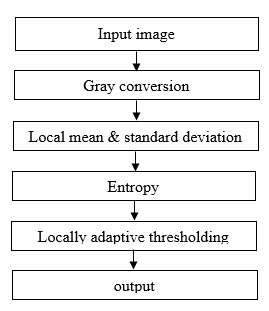Entropy-Based Locally Adaptive Thresholding for Image Segmentation
Objective
The objective of this project is to develop and implement an entropy-based locally adaptive thresholding technique for image segmentation. The proposed method aims to accurately segment images by determining optimal thresholds for each pixel, based on the local characteristics of the image.
Abstract
We presented a local thresholding method that is adaptively computed to segment images. The construction of the locally adaptive threshold mimics how human visual system interprets images, that is, identifying homogeneous regions in images in the presence of noise, clutters, and low contrast. Using a sliding window to raster scan an image, the method uses local statistics to measure homogeneity of pixel distribution in the window. The locally adaptive threshold is determined by evaluating a pixel against the local mean and an offset term, which is built by the local standard deviation and entropy. In implementation, except for the size of the sliding window, the method involves no parameters and, thus, requires no user input. For this reason, the method has a consistent and robust performance across users. Test results on different types of images demonstrated the robust performance of the method in separating fine details about an image and suppressing false positives. In practice, the method is extendable to parallel processing as the calculations are locally determined.
Keywords: segmentation, entropy, adaptive thresholding, standard deviation
NOTE: Without the concern of our team, please don't submit to the college. This Abstract varies based on student requirements.
Block Diagram

Specifications
Software: MATLAB 2020a or above
Hardware: Operating Systems:
- Windows 10
- Windows 7 Service Pack 1
- Windows Server 2019
- Windows Server 2016
Minimum: Any Intel or AMD x86-64 processor
Recommended: Any Intel or AMD x86-64 processor with four logical cores and AVX2 instruction set support
Disk:
Minimum: 2.9 GB of HDD space for MATLAB only, 5-8 GB for a typical installation
Recommended: An SSD is recommended A full installation of all Math Works products may take up to 29 GB of disk space
RAM:
Minimum: 4 GB
Recommended: 8 GB
Learning Outcomes
- Introduction to MATLAB
- What are EISPACK and LINPACK?
- How to start with MATLAB
- About Matlab language
- Matlab coding skills
- About tools & libraries
- Application Program Interface in Matlab
- About Matlab desktop
- How to use Matlab editor to create M-Files
- Features of Matlab
- Basics on Matlab
- What is an Image/pixel?
- About image formats
- Introduction to Image Processing
- How digital image is formed
- Importing the image via image acquisition tools
- Analyzing and manipulation of image.
- Phases of image processing:
- Acquisition
- Image enhancement
- Image restoration
- Color image processing
- Image compression
- Morphological processing
- Segmentation etc.,
- How to extend our work to another real time applications
- Project development Skills
- Problem analyzing skills
- Problem solving skills
- Creativity and imaginary skills
- Programming skills
- Deployment
- Testing skills
- Debugging skills
- Project presentation skills
- Thesis writing skills





 Paper Publishing
Paper Publishing
